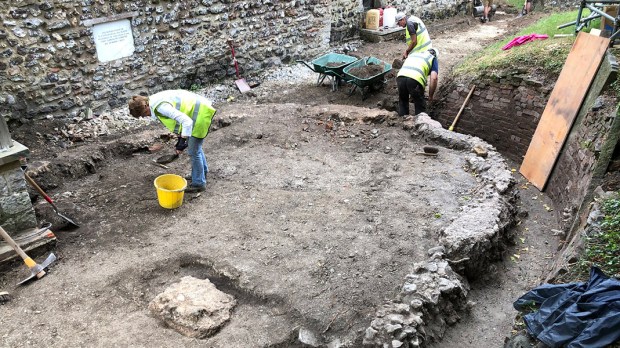The monastery of Lyminge is known for being an Anglo-Saxon royal monastery. Archaeological research demonstrates that Lyminge is one of the best preserved monastic sites in Kent – a region where Christianity first gained a foothold in Anglo-Saxon England. Because of its importance, it was repeatedly attacked by Vikings, until Alfred the Great won a decisive victory in the Battle of Edington (878) and made an agreement with the Vikings, dividing England between Anglo-Saxon territories and the Viking-ruled Danelaw. Alfred also oversaw the conversion of the Danish Viking warlord Guthrum to Christianity, and soon became the dominant ruler in England, even taking London back from its Viking occupants.
The monastery of Lyminge endured repeated Viking attacks, “but resisted collapse for almost a century, through effective defensive strategies put in place by ecclesiastical and secular rulers of Kent,” according to a group of archaeologists from the University of Reading, in charge of the Lyminge Archaeology Project.
As read in the note published by Medievalists.net, “The new evidence is presented after a detailed examination of archaeological and historical evidence by Gabor Thomas. ‘The image of ruthless Viking raiders slaughtering helpless monks and nuns is based on written records, but a re-examination of the evidence show the monasteries had more resilience than we might expect,” Thomas explains.
The monastery’s location made it especially tempting for Vikings, who raided it constantly in the later 8th and early 9th centuries. But Dr. Thomas’ archaeological research suggests that the monastic community at Lyminge “not only survived these attacks but recovered more completely than historians previously thought,” as read in his article “In the shadow of saints: The long durée of Lyminge, Kent, as a sacred Christian landscape.“
The article explains that “historical records held at Canterbury Cathedral show that after a raid in 804 CE, the monastic community at Lyminge was granted asylum within the relative safety of the walled refuge of Canterbury –a former Roman town and the administrative and ecclesiastical capital of Anglo-Saxon Kent.” But, as Medievalists.net explains, “evidence from Dr. Thomas’s dig shows the monks not only returned to re-establish their settlement at Lyminge, but continued living and building for several decades over the course of the 9th century.”

